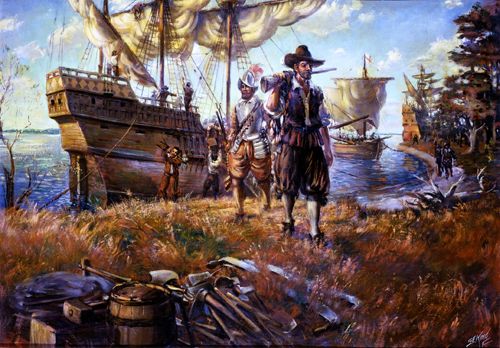
On May 13, 1607, the Jamestown colonists came ashore of the first permanent English colonisation in North America. Painting by Sidney E. King, courtesy Colonial Position Historical Park
Past Jamestown is the site of the first permanent English resolution in N America and represents the very foundations of whom and what we are as a people and a nation. Although there were other European settlements in America before Jamestown, our language, customs, and laws come from our English ancestry. Jamestown is the beginning of America.
Long before the English or any Europeans arrived, Native Americans occupied the continent for thousands of years, and archeological evidence indicates that they utilized the Jamestown area for over 10,000 geezerhood. England was a latecomer to the American scene as farthest as exploration. N America had been explored as early as the 10th century by the Vikings, followed aside Christopher Columbus in 1492 and many others.
The front attempt at settlement by the English was the fabled lost dependency of Roanoke in 1587. Twenty years subsequently, in 1607, England would establish her world-class permanent colony known as Jamestown through a joint pretend company renowned as the Virginia Companionship.
Information technology wholly began on December 6, 1606, when three ships: the Susan Faithful, the Godspeed, and the Discovery left England bound for United States. In early 1607, 104 English men and boys arrived in North America and searched for a settlement commit. On May 13, 1607, they chose Jamestown, Virginia, named afterwards their King, James I. The settlement became the original permanent English colonisation in North America.
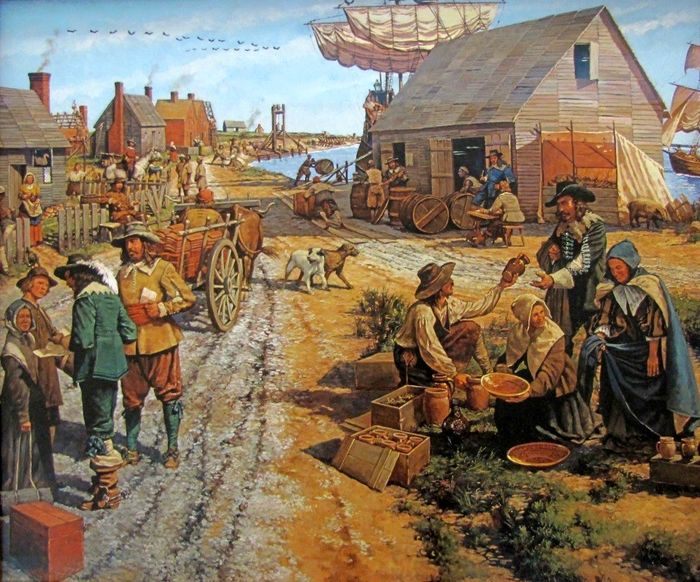
Jamestown, Virginia
The site for Jamestown was picked for several reasons, all of which met the criteria that the Virginia Company, which funded the settlement, said to follow. The site was surrounded by piddle on three sides (it was not entirely an island yet) and was far inland, some of which meant it was well defensible against possible Spanish attacks. The water was also deep enough that the West Germanic could tie their ships at the shoreline, and at the time, the site was non inhabited by Native Americans.
At one time the spot was chosen, the instructions transmitted by the Old Dominion Company, which included a inclination of the council members selected by the company, were understand. The names had been kept in certain boxes happening the ships, not to be read until a internet site was chosen. The first President of the new Virginia colony was Captain Edward I Maria Winfield. The separate six council members enclosed Bartholomew Gosnold, Christopher Newport, John Martin, John Ratcliffe, George Kendall, and Captain John Smith.
Past June 15th, a fortify was completed. It was triangle-attribute with a bulwark at each corner, holding four operating room fivesome pieces of artillery. The settlers were now protected against whatsoever attacks from the local Powhatan Indians, whose search land they were living along. Before the Jamestown immigrants' arrival, relations had already been mixed between the newcomers and the Powhatan Indians. On June 22nd, Captain Christopher Newport left for England to get more than supplies for the new settlement.
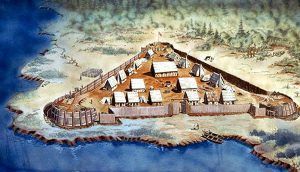
The triangular garrison at the Jamestown colony.
When the new settlers first arrived, they had been greeted by friendly Indians WHO had provided them with lavish feasts and supplies of maize. However, as the English language, deficient the inclination to farm their food, became hungry, they began to strong-fortify the natives for increasingly supplies. This straightaway caused relations to deteriorate and eventually led to conflict.
Shortly after the Captain had sailed, the settlers began to succumb to a variety of diseases. They were drinking irrigate from the salty or slimy river, which caused the decease of many an. The decease toll was high, with the men dying from swellings, malaria, fever, famine, and sometimes, in altercations with the Indians. Food for thought was running low, even up though Chief Wahunsonacock had started to send gifts of food to help the English. If non for the Powhatan Indians' help in the early years, the village would most likely throw unsuccessful.
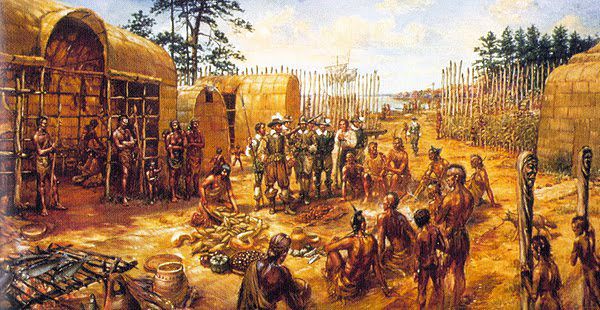
Jamestown, Old Dominion State Indians
By late 1609, the relationship between the Powhatan Indians and the English language had soured as the English were demanding too more than food during a drought. The wintertime of 1609-10 became known as the "Starving Time," and the West Germanic had become afraid to go away the fort, fearful Indians would kill them. Arsenic a leave, they ate anything they could, including individual animals, leather from their shoes and belts, and eventide resorting to cannibalism after their fellow settlers died. By early 1610 most Jamestown immigrants had died due to starvation and disease, estimated at 80-90%.
In May 1610, shipwrecked settlers who had been stranded in Bermudas finally arrived at Jamestown. Persona of a fleet sent the previous fall; the survivors used two boats built on Bermuda to get to Jamestown. Sir Thomas Bill Gates, the newly named governor, saved Jamestown in butchery with the fort's palisades torn downfield, William Henry Gates turned their hinges, and nutrient stores almost non-existent. The decision was made to abandon the settlement. However, to a lesser degree a day after leaving, Gates and the Jamestown survivors were met by news of an designate pass. The flutter was delivery their New governor, Lord DE, and the men returned to Jamestown.
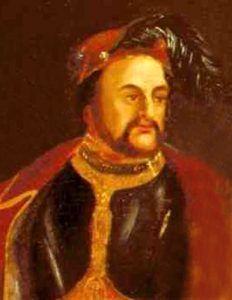
John Rolfe
In 1612, John Rolfe, one of many shipwrecked on Bermuda, helped turn the settlement into a profitable venture. He introduced a new stock of tobacco from seeds that he brought, and baccy became the prolonged-awaited Johnny Cash crop for the Virginia Company, which wanted to make money off their investment funds in Jamestown.
On July 30, 1619, newly appointed Governor Yeardley named for the first illustration legislative assembly. This was the beginning of representative regime in what would become the U.S. of US. In that same twelvemonth, the first documented Africans were brought to Virginia on a Dutch privateer send off. Some 20 Africans were traded aside the Dutch for food stores from the English. These slaves provided the requisite human resources for labour-intensive tobacco.
Also, in 1619, the Virginia Caller recruited and shipped over about 90 women to become wives of the English immigrants soh that families could be started. Though more than a hundred women had arrived in prior years, it was non until 1619 that establishing families became a primary focus.
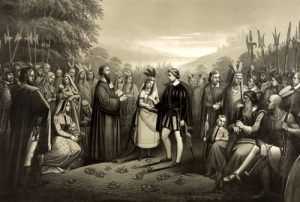
Matoaka marries Can Rolfe, away Joseph Hoover, 1867.
Peace 'tween the Indians and Pocahontas and John Rolfe concluded in 1622. In March of that year, the paramount head, Opechancanough, planned a coordinated attack against the English settlements. He was displeased the English encroachment connected Powhatan lands. Jamestown escaped being attacked due to a warning from a Powhatan boy living with the English; however, or s 350-400 of the 1,200 domain settlers were killed. After the attack, the Powhatan Indians withdrew, as was their way, and waited for the English to learn their lesson or pack upwards and depart. Erst the Side regrouped, they retaliated, and thither was fighting between the two peoples for the next decade until a weak peace was reached in 1632.
On May 24, 1624, the Virginia Company's charter was revoked by King James I due to consuming business problems and politics, and Virginia became a royal colony, which remained until the Turning Warfare. This shift in control did not change the English insurance policy towards the Indians. Despite peace treaty being announced in 1632, European nation encroachments on Powhatan lands continued undiminished as many settlers arrived.
In Apr 1644, Foreman Opechancanough planned another matched attack, which resulted in the deaths of another 350-400 of the 8,000 area settlers. The attack ended when Opechancanough was captured in 1646, seized to Jamestown, shot in the back by a guard – against orders – and killed. His successor would ulterior signal the first treaties with the European nation, which ready-made the Wahunsonacock Indians subjects of the English.
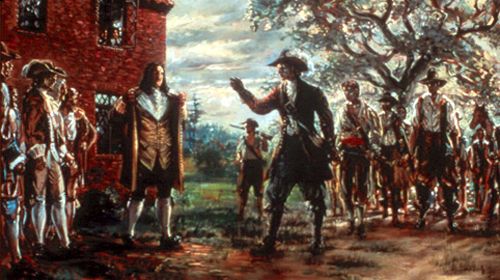
Baron Verulam's Rebellion
Bacon's Rebellion, in 1676, adage more struggles in Jamestown. The settlers were infelicitous just about their tobacco being sold only to West Germanic merchants due to the Pilotage Acts, high taxes, and attacks on far plantations by American English Indians. As a result, Nathaniel Bacon recruited about 1,000 settlers to join him to film care of the "Indian Problem." Bacon forced Regulator Berkeley to give him an official committee to attack the American Indians responsible the attacks connected the outlying plantations. However, Bacon and his followers did not differentiate 'tween those tribes amenable for the attacks and those allegiant to the English. As a result, Governor Berkeley declared Bacon a rebel, and political entity war erupted in the colony. In September, Bacon and his followers set fire to Jamestown, destroying 16 to 18 houses, the church, and the statehouse. Non long after, in October, the Insurrection began its end with the death of Nathaniel Bacon. Eventually, many of the rebels were captured, and Governor Berkeley adorned 23.
After Roger Bacon's Rebellion, another pact was signed between the West Germanic and the Virginians. More tribes were part of this treaty than the one of 1646. The pact set upwardly more mental reservation lands and reinforced a yearly protection payment of Fish and bet on that the tribes had to make to the English.
In 1698, firing struck Jamestown again when a prisoner awaiting execution in the nearby prison started a blaze. The fire scorched the prison and the statehouse, though more of the populace records were blest. In 1699, the government and Washington were moved from Jamestown to the Central Plantation, renamed Williamsburg in honor of King William III's reigning monarch. A new Capitol and "Regulator's Palace" were erected thither in the following days.
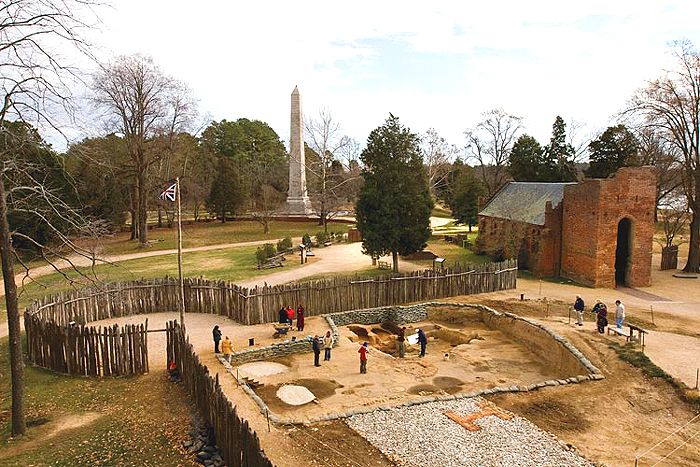
Jamestown, Virginia Today
Ascribable the movement of the capital to Williamsburg, the old town of Jamestown began to disappear slowly, though farmers continued to ringing on the island. Those who lived in the ecumenical area attended services at Jamestown's church until the 1750s, when IT, too, was abandoned.
Today, Jamestown Island is a National Historic site where visitors can walk in the steps of Captain Whoremonger Smith and Pocahontas and the separate early settlers of the first thriving West Germanic dependency.
Flash-frozen by the National Park Service and Preservation VA, the National Historic Site features an archaeological museum called the Archaearium and target-hunting and self-radio-controlled tours. Sites admit the place where the original 1607 James Fort once stood, the 17th-century church tower, and the fix of the 17th-century town. The Jamestown Glass House can as wel be visited, making glass much like it was done centuries ago at Jamestown. It is part of the Body National Historical Park, which provides views of both Old Towne and New Towne, east of the fort, which was early surveyed in the 1620s.
Because of its strategic localization, Jamestown was utilized during the War of American Independence. The fight of Green Bounce took berth solitary a short length from Jamestown. During the Civil War, United forces occupied Jamestown and secure information technology with five earthworks.
Many Information:

Replicas of the three ships which carried settlers to the Virginia settlement in 1607 are docked in the harbor.
Jamestown National Historic Land site
P.O. Package 210
Yorktown, Virginia 23690
757-856-1200
Compiled and edited by Kathy Weiser/Legends of America, updated September 2021.
Also Regard:
Nathaniel Bacon — Inaugural American Rebel
New England Settlements
The Patented Colonies
Subsidence of America – The Old Dominion
Source: National Park Service
what's the name of the fort in st augustine
Source: https://www.legendsofamerica.com/va-jamestown/